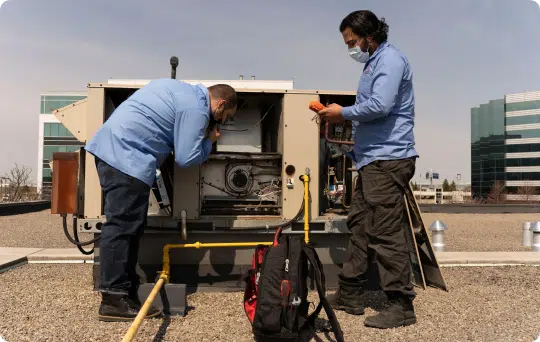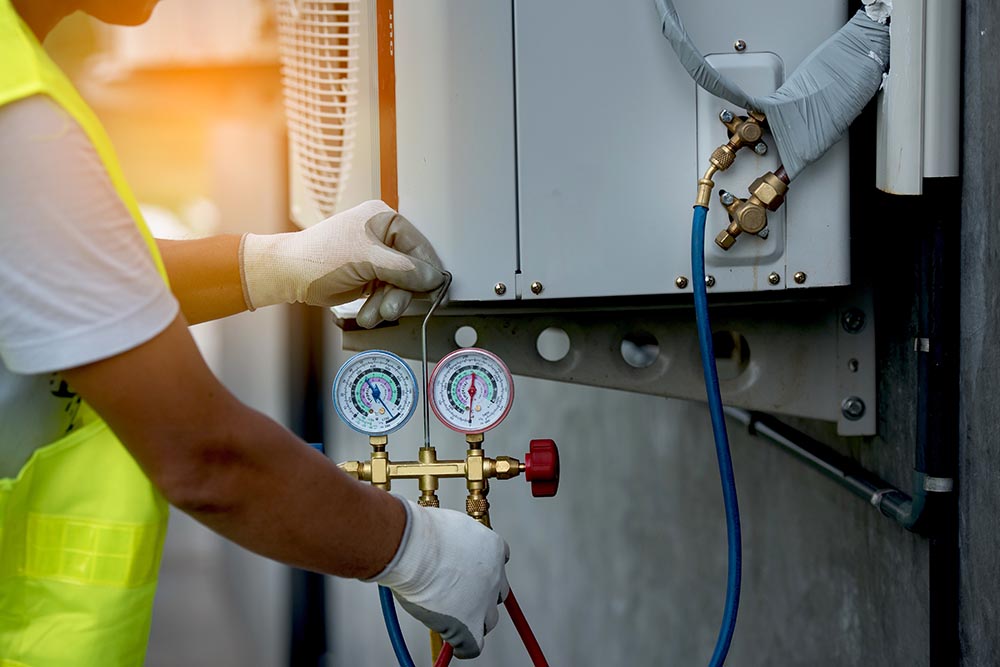How to Know It's Time for a furnace replacement
Wiki Article
Just How a Heat Pump and Furnace Work With Each Other to Optimize Your Home's Home heating Efficiency
Recognizing how a heatpump and furnace interact is essential for home owners looking for reliable home heating options. Each system has its staminas, offering a well balanced technique to home convenience. The warm pump succeeds in modest temperature levels, while the heater supplies rapid warmth during severe cold. This synergy not only lowers energy costs however additionally improves the life-span of both devices. What aspects influence this partnership, and just how can home owners maximize their advantages?Understanding Heat Pumps: How They Work
Lots of individuals may be unknown with their inner functions, warm pumps play an essential role in contemporary heating systems. These devices run by transferring warm from one location to an additional, utilizing the concepts of thermodynamics. In chillier months, a heatpump essences heat from the outside air, ground, or water, and transfers it inside to warm the home. On the other hand, during warmer months, it can turn around the procedure, acting as an ac unit by removing heat from inside to the outside.Heat pumps contain an evaporator, condenser, development, and compressor shutoff. The cooling agent within the system absorbs heat as it vaporizes at low temperatures and stress. The compressor after that raises the pressure and temperature of the refrigerant, permitting it to launch warm as it condenses. This reliable procedure can significantly decrease energy intake compared to traditional home heating techniques, making heatpump a lasting selection for climate control in homes.The Function of Furnaces in Home Home Heating
Heaters play a vital duty in home heating by supplying a trusted resource of heat during the chillier months. They run by creating heat via combustion or electric resistance, dispersing it throughout the home through air ducts or radiant systems. The efficiency of a heating system is frequently gauged by its Yearly Fuel Application Performance (AFUE) ranking, which suggests just how efficiently the unit transforms gas right into heat.Furnaces can use numerous energy sources, including natural gas, electricity, lp, or oil, permitting property owners to select the most suitable option for their demands. Unlike warm pumps, which may battle in severe cold, heaters maintain regular efficiency, making sure that indoor temperatures continue to be comfortable no matter of outside problems. In addition, modern-day furnaces typically come equipped with advanced modern technology, such as variable-speed blowers and smart thermostats, enhancing their performance and responsiveness. This adaptability makes heating systems an important part in comprehensive home heating techniques.
Advantages of Utilizing Both Systems With Each Other
Integrating the strengths of both furnaces and heat pumps can result in an extra effective and effective home heating option. Utilizing both systems permits property owners to capitalize on the heatpump's energy performance during milder temperatures while counting on the furnace for more extreme cold problems. This double approach can significantly reduce energy costs, as warm pumps eat less electricity than standard heating methods when temperatures are moderate.Additionally, utilizing both systems with each other can enhance comfort degrees in the home. Heatpump can offer constant, even home heating, while furnaces can rapidly elevate ambient temperatures when needed. The assimilation of both systems can expand the life-span of equipment by lowering wear and tear on each device, as they share the work. Eventually, homeowners can appreciate a balanced, affordable heating service that changes flawlessly to varying weather, ensuring a warm and inviting home throughout the cold weather.How Warmth Pumps and Furnaces Complement Each Other
They develop a complementary heating system that takes full advantage of effectiveness and convenience when homeowners integrate heat pumps and heaters. Warm pumps operate by moving warmth from the outside air or ground, making them extremely effective in modest climates. They excel throughout milder temperature levels, providing affordable home heating. Alternatively, heating systems create warmth via combustion or electrical resistance, providing strong, immediate warmth throughout severe cool conditions.The combination of these 2 systems allows for dynamic adjustments based upon temperature level fluctuations. Throughout warmer months or milder winter months days, the warm pump can take the lead, saving energy and lowering costs. As temperature levels decrease, the heating system can effortlessly engage, making sure regular heat throughout the home. This synergy not just optimizes energy use however also enhances the life-span of both systems, as each device operates within its suitable efficiency variety. With each other, they produce a balanced atmosphere that adapts to differing climate demands.
Maximizing Effectiveness: Tips for Homeowners
Home owners can boost their home heating performance with a number of useful strategies. Establishing a routine maintenance timetable, incorporating clever thermostat innovation, and applying reliable insulation and securing remedies are key steps. These steps not only improve convenience yet likewise reduce power costs.Normal Maintenance Schedule
To assure maximum home heating performance, establishing a normal upkeep timetable is necessary for any home. Property owners need to prioritize regular assessments of both heatpump and heaters to ascertain peak efficiency. This consists of transforming air filters each to three months, as blocked filters can greatly minimize efficiency. Furthermore, scheduling professional maintenance at least annually allows service technicians to determine and resolve prospective concerns before they rise. Property owners ought to also clean the warm pump's outside device to stop debris accumulation that can prevent air movement. By sticking to a routine maintenance timetable, homeowners not just improve their heating unit' effectiveness yet also expand their life expectancy, bring about greater comfort and reduced power costs throughout the colder months.Smart Thermostat Combination
Integrating a clever thermostat into a home heating unit can considerably boost power effectiveness, especially as it enables for exact control over temperature setups. These devices can discover the homeowner's routine and preferences, automatically readjusting the temperature level to maximize convenience while lessening power usage. They can decrease heating throughout times when the home is empty, decreasing unneeded consumption. Several wise thermostats also offer real-time energy usage data, making it possible for homeowners to make educated choices regarding their heating habits. Furthermore, remote gain access to using smartphone apps permits customers to change setups from anywhere, ensuring the home is cozy upon return. Generally, clever thermostat assimilation not only enhances comfort yet considerably adds to power financial savings and performance.
Insulation and Securing Solutions
Smart thermostats play an essential role in energy performance, but their effectiveness can be greatly enhanced by correct insulation browse around here and sealing services. Homeowners must prioritize shielding floors, walls, and attic rooms to lessen warm loss. High-grade insulation products, such as spray foam or fiberglass, can substantially enhance thermal resistance. Additionally, sealing gaps around doors, air ducts, and home windows avoids chilly air seepage and warmth escape. Weatherstripping and caulking work approaches for addressing these leakages - heat pump service. Routine examinations for air leaks, together with making use of blower door tests, can assist identify issue locations. By buying insulation and sealing, house owners can optimize the performance of their heating systems, eventually bring about minimized power usage and reduced utility expensesTypical Myths About Heat Pumps and Furnaces
What mistaken beliefs surround heatpump and heaters? Several people wrongly believe that warmth pumps are inefficient in chillier climates. In fact, modern-day heat pumps are designed to operate effectively also in low temperature levels, offering trustworthy heating throughout wintertime. One more common misconception is that heating systems are go constantly much more effective than heatpump. However, this relies on the particular power resources and effectiveness rankings of the units concerned. Some might additionally assume that utilizing both systems concurrently is unneeded, however in truth, this mix can optimize home heating efficiency, specifically throughout extreme weather. In addition, individuals often presume that heatpump call for continuous maintenance, when in truth, they have comparable maintenance requires to conventional heater. By disproving these misconceptions, home owners can make more educated choices regarding their heating options, ultimately bring about improved comfort and power effectiveness in their homes.Maintenance Factors To Consider for Combined Solutions

Regularly Asked Concerns
Can Warmth Pumps Job Efficiently in Incredibly Cold Climates?
Heatpump can have a hard time in exceptionally cool climates because of minimized performance and heat removal limitations. Nonetheless, advancements in modern technology have actually brought about designs developed for better performance in such conditions, boosting their practicality in severe atmospheres.
For How Long Do Warm Pumps and Furnaces Generally Last?
Heatpump normally last 15 to 20 years, while heaters have a life expectancy of 15 to thirty years. Routine maintenance can expand their long life, making certain effective operation and decreasing the demand for premature replacements.
What Is the Typical Price of Installing Both Equipments?
The average expense of setting up both a heatpump and a heater normally ranges in between $5,000 to $10,000 - heat pump installation ooltewah tn. Elements affecting this expense consist of system size, installment intricacy, and regional labor pricesExist Tax Obligation Incentives for Using Energy-Efficient Heating Systems?
Several homeowners inquire concerning tax obligation rewards for energy-efficient home heating systems. Various federal and state programs usually provide credits or rebates, urging the adoption of sustainable innovations to minimize power intake and promote environmental duty.Just how Do I Pick the Right Dimension Heat Pump and Heater?
Selecting the right dimension heatpump and heater involves calculating the home's square footage, thinking about insulation quality, and evaluating neighborhood climate. Consulting a specialist can guarantee ideal system performance and power effectiveness based upon particular requirements. furnace replacement. Recognizing just how a warmth pump and heater job with each other is necessary for property owners looking for reliable heating solutions. In colder months, a warm pump essences warmth from the outdoors air, ground, or water, and transfers it indoors to warm the living space. When property owners integrate heat pumps and heaters, they develop a complementary home heating system that makes the most of effectiveness and comfort. Warm pumps operate by moving warmth from the outside air or ground, making them highly effective in moderate environments. Heat pumps can have a hard time in extremely cold climates due to reduced effectiveness and heat removal constraintsReport this wiki page